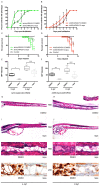A zebrafish model of chordoma initiated by notochord-driven expression of HRASV12
- PMID: 24311731
- PMCID: PMC4073279
- DOI: 10.1242/dmm.013128
A zebrafish model of chordoma initiated by notochord-driven expression of HRASV12
Abstract
Chordoma is a malignant tumor thought to arise from remnants of the embryonic notochord, with its origin in the bones of the axial skeleton. Surgical resection is the standard treatment, usually in combination with radiation therapy, but neither chemotherapeutic nor targeted therapeutic approaches have demonstrated success. No animal model and only few chordoma cell lines are available for preclinical drug testing, and, although no druggable genetic drivers have been identified, activation of EGFR and downstream AKT-PI3K pathways have been described. Here, we report a zebrafish model of chordoma, based on stable transgene-driven expression of HRASV12 in notochord cells during development. Extensive intra-notochordal tumor formation is evident within days of transgene expression, ultimately leading to larval death. The zebrafish tumors share characteristics of human chordoma as demonstrated by immunohistochemistry and electron microscopy. The mTORC1 inhibitor rapamycin, which has some demonstrated activity in a chordoma cell line, delays the onset of tumor formation in our zebrafish model, and improves survival of tumor-bearing fish. Consequently, the HRASV12-driven zebrafish model of chordoma could enable high-throughput screening of potential therapeutic agents for the treatment of this refractory cancer.
Keywords: Cancer; Chordoma; Drug treatment; HRASV12; Rapamycin; Zebrafish.
© 2014. Published by The Company of Biologists Ltd.
Figures



References
-
- Davison J. M., Woo Park S., Rhee J. M., Leach S. D. (2008). Characterization of Kras-mediated pancreatic tumorigenesis in zebrafish. Methods Enzymol. 438, 391–417 - PubMed
-
- Du S. J., Dienhart M. (2001). Zebrafish tiggy-winkle hedgehog promoter directs notochord and floor plate green fluorescence protein expression in transgenic zebrafish embryos. Dev. Dyn. 222, 655–666 - PubMed
-
- Eisenberg M. B., Woloschak M., Sen C., Wolfe D. (1997). Loss of heterozygosity in the retinoblastoma tumor suppressor gene in skull base chordomas and chondrosarcomas. Surg. Neurol. 47, 156–160, discussion 160–161 - PubMed
Publication types
MeSH terms
Substances
Grants and funding
- R01 DK070263/DK/NIDDK NIH HHS/United States
- R03 DK097443/DK/NIDDK NIH HHS/United States
- DK071041/DK/NIDDK NIH HHS/United States
- R37 CA058596/CA/NCI NIH HHS/United States
- DK053093/DK/NIDDK NIH HHS/United States
- R03DK097443/DK/NIDDK NIH HHS/United States
- R01 DK071041/DK/NIDDK NIH HHS/United States
- R01 CA129933/CA/NCI NIH HHS/United States
- K08DK082782/DK/NIDDK NIH HHS/United States
- HHMI/Howard Hughes Medical Institute/United States
- DK070263/DK/NIDDK NIH HHS/United States
- R01 DK053093/DK/NIDDK NIH HHS/United States
- K08 DK082782/DK/NIDDK NIH HHS/United States
LinkOut - more resources
Full Text Sources
Other Literature Sources
Molecular Biology Databases
Research Materials
Miscellaneous

